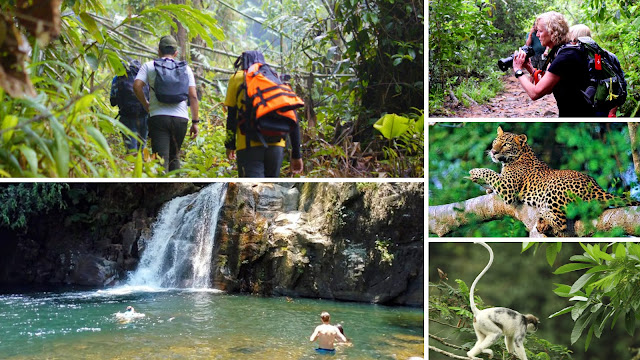Sinharaja Forest: The Jewel of Sri Lanka's Biodiversity
Geographical Significance
Location: Sinharaja is located in the wet zone in Sri Lanka and is surrounded by central mountains towards one side and Indian Ocean to its other side.
Climate: The forest receives huge rainfall in the range of 3000 to 6000 mm per annum resulting in a very dense vegetation cover with a rich and varied ecosystem.
Topography: steep hills and steep valleys, and the tallest peak is Hinipitigala, 1,171m above sea level.
Biodiversity Hotspot
Sinharaja is globally acclaimed as a hotspot of biodiversity, being home to numerous varieties of species,
Flora: The woods embrace a total of 340 tree species, about 192 of them are endemic to Sri Lanka. Big examples of them include the cast-iron dipterocarp trees, with many others ranging from ferns to orchids.
Fauna: There are about 160 species of birds that inhabit the forest, including the endemic Sri Lankan Blue Magpie, and the Purple-faced Langur. Besides, there are several varieties of reptiles, amphibians, and insects, most of which have unique species in the area.
Conservation Initiatives
Conservation: In 1988, Sinharaja Forest was declared a national heritage, while in 1989, it was designated as a world heritage site by the UNESCO.
Threats to Conservation: Well, though the forest lands are well protected, it suffers from the nefarious, illegal logging, encroachments, and climatic change, making it necessary to save this special ecosystem.
Flora and Fauna Overview
We have the presence of really diverse plant life here at the forest. As a result, density comes up to just about 240,000 plants per hectare. Canopy layers include:
Emergent Layer: The emergent layer of the Sinharaja Forest is the highest among the canopies of the dense rainforest and is part of the World's Heritage Site in Sri Lanka. Comprising tall trees rising above the main canopy, some of which are more than 45 m tall, to capture the sunlight, these emergent trees like Dipterocarps adapted themselves to high winds and direct sunlight. They form an important habitat for a variety of birds, insects, and other wildlife, some of which are endemic like the Sri Lankan blue magpie. The role of the emergent layer in the whole forest ecosystem is regulating microclimates while supporting biodiversity. The existence of this layer is a most vital component that sustains the ecological balance of Sinharaja itself.
Level Canopy: Above the floor, the rainforest of Sinharaja holds a canopy that is fully closed and almost 30-40 meters above the ground. This layer is the most productive part of the forest wherein life thrives; primarily, it is the habitat of several other species. It mostly comprises the forests which have the giant trees, such as the endemic Dipterocarps. Thus, in the canopy, it has a variety of flora and fauna. These include different species of birds, insects, mammals, and epiphytes such as orchids and ferns. It mainly regulates the microclimate of the forest, conserving moisture, adjusting the balance of the ecosystem for the benefit of the biodiversity in Sinharaja.
Sub Canopy: Under the main canopy is the sub-canopy layer of Sinharaja Forest: a shaded, labyrinthine zone filled with smaller trees, saplings, and shrubs. This layer with a height range of 10-20 m flourishes under filtered light and therefore is an important structural element of the forest. It provides habitat to different fauna, including birds, reptiles, and insects, many of them endemic to Sri Lanka. Furthermore, the sub-canopy is a nursery for young trees, thereby facilitating the regeneration of the forests. It is this thick vegetation, with the ability to provide cover and food, that greatly aids Sinharaja in harboring an extraordinary amount of biodiversity and ecological equilibrium.
Ground Level: The ground level of Sinharaja Forest is a dark, humid, and nutrient-rich layer teeming with life. Covered with leaf litter, fallen branches, and decomposing organic matter, it serves as the foundation of the forest ecosystem. This layer supports a variety of fungi, insects, and small mammals, which play a crucial role in breaking down organic material and recycling nutrients. It is also home to amphibians, reptiles, and ground-dwelling birds. The dense shade from the canopy above limits plant growth, but ferns, mosses, and seedlings thrive here. This layer is vital for maintaining soil health and supporting Sinharaja’s biodiversity.
Animal Life: In the forest growing numerous endemic species-Sri Lanka blue magpie, purple-faced langur, green pit viper among them-The Sri Lankan leopards, giant squirrels, and barking deer, which are seldom found, are vieing for attention. For reptiles, the forest has been graced with its share of the hump-nosed lizard; the hourglass tree frog for amphibians. An abundance of invertebrates-interesting butterflies and weird beetles-thereby proudly adding to that rich biodiversity. The forest with thick vegetation provides suitable habitat, thus acting as an important refuge for Sri Lankan fauna.
Mammals:
The Sinharaja Forest is a rainforest in Southwest Sri Lanka that has been designated a UNESCO World Heritage Site and harbors a diverse mammalian fauna that is mostly endemic. In particular, it carries the Sri Lankan leopard, the purple-faced langur, and the giant squirrel, where all three species symbolize this region. Other mammals include the barking deer, wild boar, and Indian muntjac. Being dense in canopy and undergrowth, the forest provides shelter and food sources to these mammals. Sinharaja's mammals help keep the ecosystem balanced through seed dispersal and regulating the prey populations. Their habitat is an important demand for the survival of some very unique mammals.
Birds: Sinharaja Forest – a UNESCO World Heritage Site in Sri Lanka – is a veritable heaven for birdwatchers, sheltering more than 160 bird species out of which 33 are endemic. Among these is the Sri Lanka blue magpie, the red-faced malkoha, and the Sri Lankan spurfowl, all seen as features or icons in this biodiverse heaven. The canopy and undergrowth of forests form perfect nests and feeding habitats. The birdlife in it is good because it has numerous insects, fruits, and nectars for food. This is an important site for carrying out activities that concern birds, and it is a good field for watching rare, colorful birds. With this comprehensive avian catalogue, it makes a good birding and nature bite.
Reptiles and Amphibians: The Sinharaja Forest, established in World Heritage site of UNESCO, is the prevailing habitat for a variety of reptiles and amphibians. It is a haven for endemic species like the green pit viper, hump-nosed lizard, and Sri Lanka kangaroo lizard cater to the moistened canopy aadam hourglass tree frogs and Sri Lanka rock frogs among the amphibians Crocodiles and other relatives. These cases of open or cool shade, preferably in a moisture-wrapped environment, are prime examples of the underbellies of these highly conditional, cold-blooded creatures. Reptiles and amphibians maintain great responsibilities between both ecosystems: suppressing insect populations and acting as health indicators. The biodiversity of Sinharaja exemplifies the relevance of this habitat as a refuge for these almost non-existent.
Visitor Experience
Accessibility: The nearest major cities are Galle and Matara, with various transportation options available to reach the forest.
Guided Tours: It is highly recommended to hire local guides who can provide insights into the forest's ecology and help navigate the trails.
Things to do in Sinharaja Forest
Trekking and Hiking
Wander through the vast trail network crisscrossing the forest.
Some most-preferred trailheads include Makandawa Forest Reserve, Pitadeniya Entrance.
Hiking types can vary from short walks to all-day treks depending on physical condition.
Birdwatching
Birdwatching here is indeed one of the highlights, with over 160 bird species, including many endemics, such as the Sri Lankan Blue Magpie. Early morning is the best time to go birdwatching because most species tend to be active during this time.
Early morning is the best with respect to bird watching since most species are active during that time.
Photography
Photograph incredible vistas, dynamic vegetation, and wide-ranged fauna.
The forests' peculiar lighting gives better nature photography opportunities.
Guided Tours
It is advisable to enlist the services of a local guide to augment your experience.
They offer much information about the ecology, history of the forest, and the various species that will likely be encountered.
Wildlife Spotting
Look out for some endemic mammals such as the Purple-faced Langur and the Sri Lankan Elephant.
The prime wildlife location also includes the existence of some reptiles and amphibians.
Swimming in Waterfalls
You might go for a good refreshing swim in the natural pools at the falls of Kekuna Ella.
These are the perfect spots for lazing after a good hike.
Night Walks
You may arrange for an enjoyable evening walk to experience the nocturnal lives of the forest.
This would be the time to see various species that come to life only after dark.
Experiences in Culture
Interact with the local people surrounding the forest.
Traditional activities like tea cultivation or handicrafts can give one a glimpse into local culture.
Education in Nature
Then, with the help of local knowledgeable guides, learn about the various unique species of flora and fauna found in the rainforest.
This is sure to give one an extremely good education on the ecosystem.
Relaxation and Reflection
Time should be no longer spent enjoying the peace of the forest.
Look for a secluded location and meditate or reflect within the purely natural surroundings.
Activities which are not life might be out to reveal something most interesting about the component wonders of Sinharaja Forest, leaving one with even greater understanding of its significance in ecology.
Cultural Importance
Local Communities: Surrounding the forest are a few small villages where the local communities value the traditional practices of tea cultivation and handicrafts involving handlooms and terracotta pots.
Cultural Experiences: The visitors can share in the social activities available to them and visit the local community to learn about their traditional lifestyles.
Location
Shared route
From Colombo Bandaranaike International Airport to Sinharaja Forest Reserve via Southern Expy/E01.
3 hr 14 min (158 km)
For the best route in current traffic visit https://maps.app.goo.gl/xbRXsJpAfeKCqwcc6
Conclusion
Sinharaja Forest is truly a treasure of ecological wonders, being both a UNESCO World Heritage Site and biodiversity hot spot in Sri Lanka. It comprises such ecological categories as emergent, canopy, sub-canopy, and ground, supporting diverse flora and fauna of many cultures, almost unfathomable.This place is home to a range of endemic species, including mammals such as the purple-faced langur and Sri Lankan leopard, birds like the Sri Lanka blue magpie, and reptiles including the green pit viper. This lush ecosystem is further enriched by myriad amphibians, insects, and countless plant species.
The intricate architecture of the forest and its microclimatic regime provided ideal habitats to all the organisms living there and maintained a precarious balance of life. Sinharaja has an indispensable role to play in carbon sequestration and water and soil conservation making it very important for the health of the environment at the local as well as global levels. Conservation of Sinharaja is indispensable for the conservation of biodiversity, mitigation of climate change, and facilitation of research.
The Sinharaja still faces threats such as deforestation, adverse effects of climate change, and human encroachment. Community involvement and sustainable tourism are key ingredients acts for conservation against this irreplaceable heritage. Sinharaja Forest glorifies the beauty and complexity nature cradles and reminds us of the importance of conserving these ecosystems for future generations. It is not a local but an international responsibility to save this legacy.











No comments:
Post a Comment